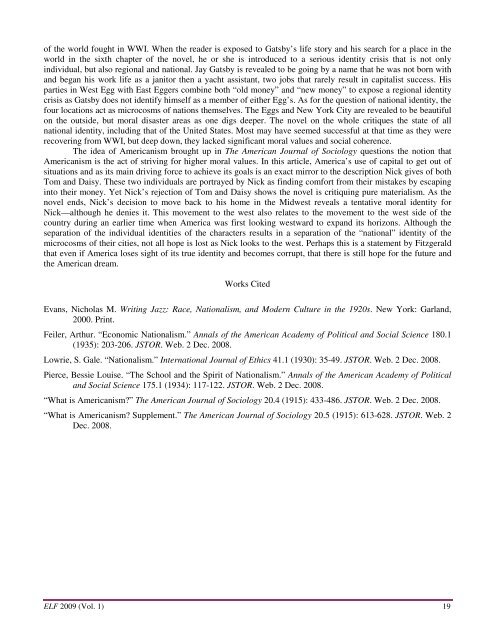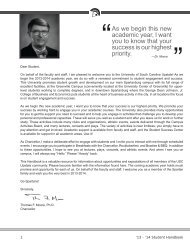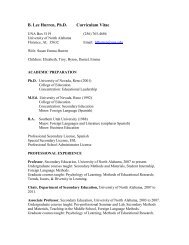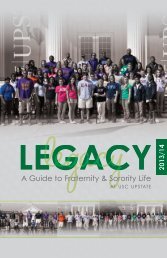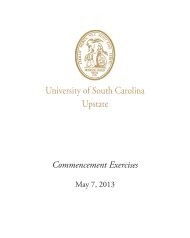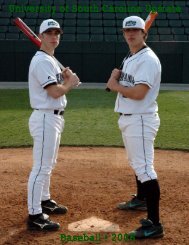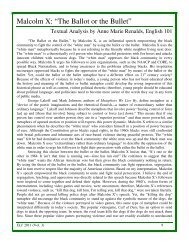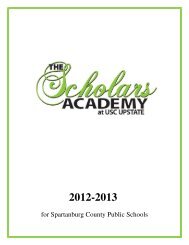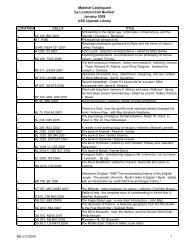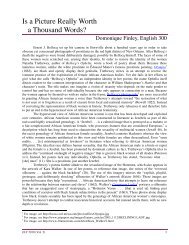The Identity Crisis of the Modernist Era
The Identity Crisis of the Modernist Era
The Identity Crisis of the Modernist Era
Create successful ePaper yourself
Turn your PDF publications into a flip-book with our unique Google optimized e-Paper software.
<strong>of</strong> <strong>the</strong> world fought in WWI. When <strong>the</strong> reader is exposed to Gatsby’s life story and his search for a place in <strong>the</strong>world in <strong>the</strong> sixth chapter <strong>of</strong> <strong>the</strong> novel, he or she is introduced to a serious identity crisis that is not onlyindividual, but also regional and national. Jay Gatsby is revealed to be going by a name that he was not born withand began his work life as a janitor <strong>the</strong>n a yacht assistant, two jobs that rarely result in capitalist success. Hisparties in West Egg with East Eggers combine both “old money” and “new money” to expose a regional identitycrisis as Gatsby does not identify himself as a member <strong>of</strong> ei<strong>the</strong>r Egg’s. As for <strong>the</strong> question <strong>of</strong> national identity, <strong>the</strong>four locations act as microcosms <strong>of</strong> nations <strong>the</strong>mselves. <strong>The</strong> Eggs and New York City are revealed to be beautifulon <strong>the</strong> outside, but moral disaster areas as one digs deeper. <strong>The</strong> novel on <strong>the</strong> whole critiques <strong>the</strong> state <strong>of</strong> allnational identity, including that <strong>of</strong> <strong>the</strong> United States. Most may have seemed successful at that time as <strong>the</strong>y wererecovering from WWI, but deep down, <strong>the</strong>y lacked significant moral values and social coherence.<strong>The</strong> idea <strong>of</strong> Americanism brought up in <strong>The</strong> American Journal <strong>of</strong> Sociology questions <strong>the</strong> notion thatAmericanism is <strong>the</strong> act <strong>of</strong> striving for higher moral values. In this article, America’s use <strong>of</strong> capital to get out <strong>of</strong>situations and as its main driving force to achieve its goals is an exact mirror to <strong>the</strong> description Nick gives <strong>of</strong> bothTom and Daisy. <strong>The</strong>se two individuals are portrayed by Nick as finding comfort from <strong>the</strong>ir mistakes by escapinginto <strong>the</strong>ir money. Yet Nick’s rejection <strong>of</strong> Tom and Daisy shows <strong>the</strong> novel is critiquing pure materialism. As <strong>the</strong>novel ends, Nick’s decision to move back to his home in <strong>the</strong> Midwest reveals a tentative moral identity forNick—although he denies it. This movement to <strong>the</strong> west also relates to <strong>the</strong> movement to <strong>the</strong> west side <strong>of</strong> <strong>the</strong>country during an earlier time when America was first looking westward to expand its horizons. Although <strong>the</strong>separation <strong>of</strong> <strong>the</strong> individual identities <strong>of</strong> <strong>the</strong> characters results in a separation <strong>of</strong> <strong>the</strong> “national” identity <strong>of</strong> <strong>the</strong>microcosms <strong>of</strong> <strong>the</strong>ir cities, not all hope is lost as Nick looks to <strong>the</strong> west. Perhaps this is a statement by Fitzgeraldthat even if America loses sight <strong>of</strong> its true identity and becomes corrupt, that <strong>the</strong>re is still hope for <strong>the</strong> future and<strong>the</strong> American dream.Works CitedEvans, Nicholas M. Writing Jazz: Race, Nationalism, and Modern Culture in <strong>the</strong> 1920s. New York: Garland,2000. Print.Feiler, Arthur. “Economic Nationalism.” Annals <strong>of</strong> <strong>the</strong> American Academy <strong>of</strong> Political and Social Science 180.1(1935): 203-206. JSTOR. Web. 2 Dec. 2008.Lowrie, S. Gale. “Nationalism.” International Journal <strong>of</strong> Ethics 41.1 (1930): 35-49. JSTOR. Web. 2 Dec. 2008.Pierce, Bessie Louise. “<strong>The</strong> School and <strong>the</strong> Spirit <strong>of</strong> Nationalism.” Annals <strong>of</strong> <strong>the</strong> American Academy <strong>of</strong> Politicaland Social Science 175.1 (1934): 117-122. JSTOR. Web. 2 Dec. 2008.“What is Americanism?” <strong>The</strong> American Journal <strong>of</strong> Sociology 20.4 (1915): 433-486. JSTOR. Web. 2 Dec. 2008.“What is Americanism? Supplement.” <strong>The</strong> American Journal <strong>of</strong> Sociology 20.5 (1915): 613-628. JSTOR. Web. 2Dec. 2008.ELF 2009 (Vol. 1) 19


